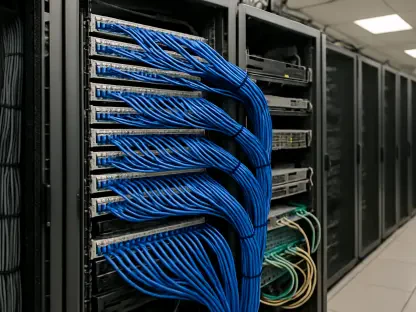The recent disclosure of critical microcode vulnerabilities in AMD processors has sent ripples through the tech industry. These flaws, which could potentially compromise Secure Encrypted Virtualization (SEV), were inadvertently revealed by a partner before AMD had the chance to release official patches. This article delves into the nature of these vulnerabilities, AMD’s response, and the broader implications for the industry.
The Initial Disclosure and Immediate Risks
Unintentional Revelation of Vulnerabilities
The vulnerabilities in AMD’s microcode were accidentally disclosed by a partner, creating a window of heightened risk. During this period, systems were exceptionally vulnerable to potential exploits, as the official patches had not yet been released. This unplanned disclosure underscored the critical nature of the flaws, which could allow attackers with administrative privileges to load malicious microcode. With administrative access, a bad actor could potentially undermine the entire system’s security, making this period particularly perilous for those relying on the affected AMD processors.
The sudden revelation of these vulnerabilities caught many by surprise, illustrating the precarious balance tech companies must maintain between security and operational transparency. The premature exposure meant that, for a critical period, various systems were left at significant risk without any immediate mitigation strategies available. This incident is a vivid reminder of the high stakes involved in managing advanced security protocols within the tech industry, emphasizing the need for careful planning and robust defenses to protect against such vulnerabilities.
Impact on Secure Encrypted Virtualization (SEV)
The primary concern with these vulnerabilities was their impact on SEV, a feature designed to protect virtual machines. SEV is crucial for maintaining the security and integrity of virtualized environments, and any compromise could lead to significant data breaches. The disclosure highlighted the importance of swift action to mitigate these risks. Secure Encrypted Virtualization ensures that virtual machines remain isolated and secure, preventing unauthorized access to sensitive data, which is indispensable in our increasingly virtualized world.
Compromising SEV could lead to unauthorized access to sensitive information within virtual machines, escalating the potential damage from these vulnerabilities. For many enterprises, SEV serves as a cornerstone of their cybersecurity strategies, making any threats to its integrity a matter of significant concern. The potential ramifications of these vulnerabilities extend beyond mere technical challenges; they threaten the very foundations of digital trust and data privacy that modern businesses and users rely on.
AMD’s Swift Response and Patch Deployment
Release of Corrective Patches
In response to the disclosure, AMD quickly issued two patches aimed at addressing the vulnerabilities. These patches were designed to secure the microcode and restore the integrity of SEV. The rapid release of these patches demonstrated AMD’s commitment to protecting its users and maintaining the security of its products. While the swift issuance of these patches is commendable, it also highlights the rigor and preparedness essential for mitigating such high-stakes vulnerabilities in real-time.
AMD’s ability to develop and distribute these patches promptly underscores its capacity for responsive security management. This response was crucial, given the gravity of the vulnerabilities and their potential to exploit SEV. By moving quickly to release these patches, AMD aimed to close the window of heightened risk introduced by the premature vulnerability disclosure, thereby reinforcing its resolve to maintain secure environments for users and enterprises alike.
Coordination with OEMs
The implementation of microcode patches is a complex process that relies heavily on Original Equipment Manufacturers (OEMs). AMD worked closely with its partners to ensure the timely distribution and application of these patches. However, the dependence on OEMs introduced potential delays, as each manufacturer needed to adopt and deploy the updates across their hardware. This collaboration is vital, yet it inevitably introduces variability in how quickly different systems across various enterprises can achieve full protection.
Due to the reliance on OEMs, some systems may experience delays in receiving the necessary patches, extending the period during which they are exposed to potential exploitation. This scenario underscores the critical role OEMs play in the broader cybersecurity ecosystem, where their cooperation and speed in deploying updates can significantly influence the overall effectiveness of vulnerability mitigation efforts. Proper coordination and communication between AMD and its OEM partners are essential to ensure swift and comprehensive protection for all affected systems.
Industry Reactions and Expert Insights
Perspectives from Security Experts
The industry’s response to AMD’s handling of the situation has been largely positive. Experts like John Price from SubRosa and Flavio Villanustre from LexisNexis Risk Solutions praised AMD’s swift and coordinated response. They acknowledged the challenges associated with microcode patches but commended AMD for its transparency and proactive measures. Such endorsements from industry professionals highlight the importance of confidence and trust in the effectiveness of AMD’s response strategy.
Additionally, these experts emphasized the critical role of collaboration in addressing security vulnerabilities effectively. The positive feedback from these seasoned professionals validates AMD’s approach and provides a measure of reassurance to users and enterprises that rely on AMD’s products. Despite the inherent complexities of dealing with microcode vulnerabilities, AMD’s proactive stance and timely remediation efforts have proven to be decisive factors in managing this significant security challenge.
Potential Delays in Patch Adoption
Despite the positive feedback, experts also highlighted the potential for delays in patch adoption. The reliance on OEMs means that the timeframe for resolving the issue can vary significantly between enterprises. Some OEMs have already begun implementing the fixes, while others are at different stages, leading to potential exposure variances. This unpredictable timeline presents an ongoing challenge for maintaining consistent security across diverse environments.
The gap in patch adoption timelines creates a variable security landscape, where some systems might remain vulnerable longer than others. This disparity calls for more streamlined collaboration and perhaps even alternative strategies to expedite patch deployment. Ensuring that all affected systems are updated promptly requires not only efficient communication and coordination among AMD, OEMs, and enterprises but also a reevaluation of the processes that govern such critical updates.
The Technical Challenges of Microcode Patches
Complexity of Microcode Updates
Microcode updates are inherently complex, requiring careful coordination between AMD, OEMs, and end-users. These updates often necessitate system reboots and can introduce temporary disruptions. The article emphasizes the importance of updating the UEFI to prevent microcode issues from recurring upon server reboots. This complexity underscores the technical sophistication required to maintain and update modern microcode, ensuring both security and functionality.
The intricate nature of microcode updates means that each step must be meticulously planned and executed to avoid unintended consequences. The requirement for system reboots adds another layer of complexity, as these can disrupt normal operations and necessitate planning and communication to minimize downtime. By emphasizing the significance of UEFI updates, AMD aims to bolster the robustness of their microcode protections, ensuring that vulnerabilities do not persist through system reboots.
Future Implications for Emergency Patches
The recent vulnerabilities have highlighted the need for robust processes to handle emergency patches. Firmware issues, in particular, pose significant challenges due to their embedded nature. Experts like Matt Kimball from Moor Insights & Strategy stress the importance of having contingency plans in place to address such emergencies swiftly and effectively. The lessons learned from this incident underscore the ongoing need for agility and preparedness in the face of evolving security threats.
The timing and execution of emergency patches demand a high degree of coordination and precision. The embedded nature of firmware vulnerabilities exacerbates these challenges, making the development and deployment of patches more intricate. Preparing for such emergencies involves not only technical readiness but also strategic planning and collaboration between all stakeholders. Moving forward, the industry must cultivate these capabilities to ensure swift, effective responses to future security challenges.
Broader Implications for the Tech Industry
Importance of Secure Virtualization
The vulnerabilities in AMD’s microcode have underscored the critical importance of secure virtualization. As more enterprises rely on virtualized environments, the need for robust security measures becomes paramount. The article discusses how the industry can learn from this incident to enhance the security of virtualized systems. From data centers to cloud services, ensuring the integrity and confidentiality of virtual machines is essential for maintaining trust and operational effectiveness.
The incident serves as a poignant reminder for the tech industry to continually evaluate and upgrade its security protocols. As virtualized environments become more ubiquitous, so too does the need for comprehensive security frameworks that can effectively shield against evolving threats. Emphasizing secure virtualization involves not only adopting advanced technologies but also fostering a culture of security awareness and proactive risk management.
Lessons Learned and Future Directions
The recent revelation of significant microcode vulnerabilities in AMD processors has created a stir in the tech world. These weaknesses, which have the potential to weaken Secure Encrypted Virtualization (SEV), were accidentally disclosed by a partner before AMD had the opportunity to release official patches. This premature disclosure has raised concerns about the security of AMD’s encryption protocols and the effectiveness of its update process. This article explores the specifics of these security flaws, AMD’s reaction, and the wider implications for the tech industry. With data security being of paramount importance, such exposures highlight the urgent need for robust systems and prompt responses. The incident underscores the critical nature of timely updates and the cooperation necessary among tech companies to safeguard against threats. AMD’s future strategies will be particularly scrutinized to ensure such vulnerabilities are addressed swiftly, preventing potential compromises of data integrity and security.









